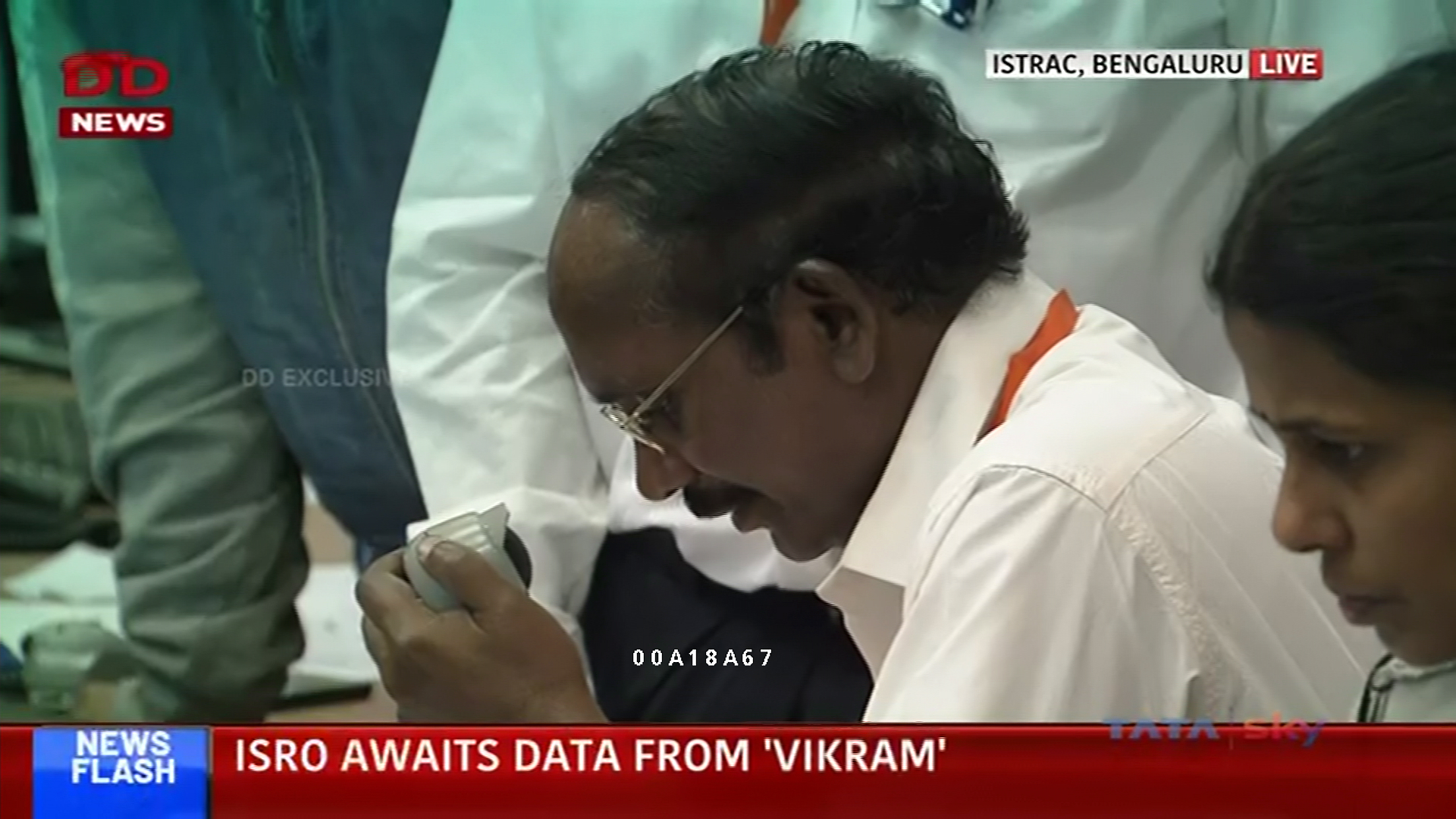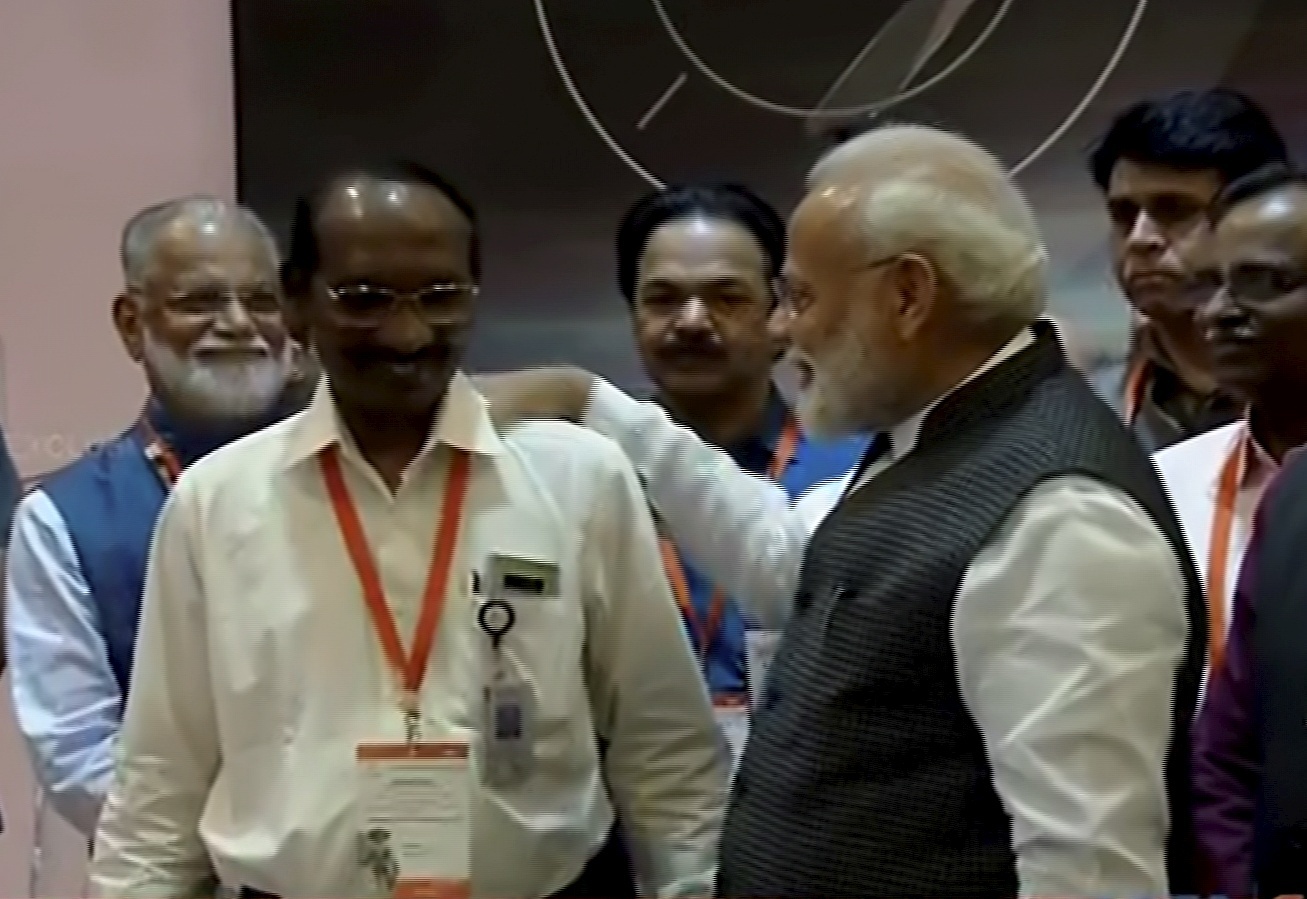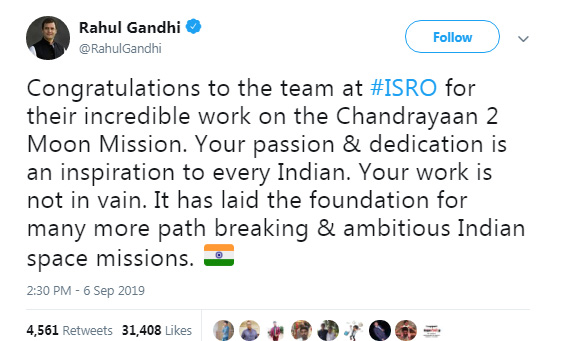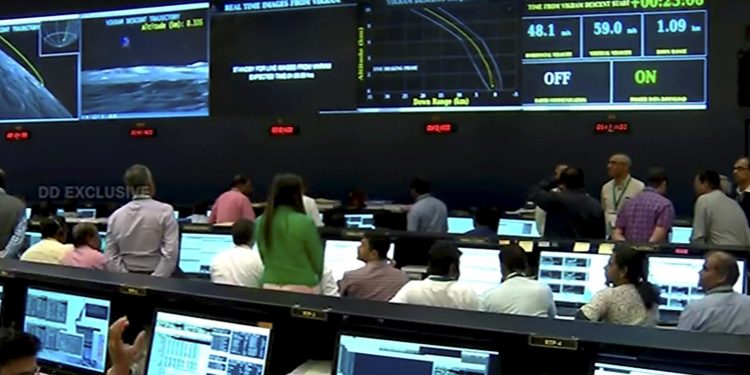Bangalore: Indian Space Research Organisation’s (ISRO) plan to soft land Chandrayaan-2’s ‘Vikram’ module on the Lunar surface did not go as per script in the early hours of Saturday, with the lander losing communication with ground stations during its final descent.
The ‘terrifying 15 minute’ complex landing process, which commenced with a lot of expectation, tinged with a sense of jubilation was going on well till the successful rough braking phase which was marked by rounds of applause.

When the top ISRO scientists including its chief K Sivan looked glum soon after the subsequent fine braking phase commenced, it was the first indication that all was not well.
Scientists led by K Sivan went into a huddle and Prime Minister Narendra Modi, who was keenly tracking the progress was briefed on the development and a sombre mood enveloped the Mission Operations Complex at ISRO Telemetry, Tracking and Command Network (ISTRAC) here which quickly led to dejection; all in a span of about half an hour after the process began.
Later, Sivan made the announcement that communication was lost with the lander, while Narendra Modi boosted the morale of the scientists asking them not to lose hope.
‘Vikram’s’ descent was as planned and normal performance was observed up to an altitude of 2.1 km. Subsequently, communication from the lander to ground stations was lost, ISRO Chairman K Sivan said, his voice choked with emotion. “The data is being analysed,” Sivan said.
Modi, who flew into this city Friday night to watch the planned touchdown of ‘Vikram’, told ISRO scientists not to get dejected and disheartened and said the country was proud of them.

“I see disappointment on your faces. No need to get dejected. We have learnt a lot,” Modi said. “These are moments to be courageous, and courageous we will be! We remain hopeful and will continue working hard on our space programme.”
For ISRO the ‘15 minutes of terror’ arrived as the powered descent of the lander began at around 1.38 am. “This is a very complex process and it is new for us. We are doing this for the first time, so it will be 15 minutes of terror for us,” Sivan had said earlier.
Till the communication was snapped, the Prime Minister was found glued to the giant monitors which was tracking the descent. He was also listening keenly to some scientists who were explaining the nitty-gritty of the operation.
The 1,471-kg ‘Vikram’, named after Dr Vikram A Sarabhai, father of the Indian space programme, was designed to execute a soft landing on the lunar surface, and to function for one lunar day, which is equivalent to about 14 earth days.
‘Vikram’ was to perform a series of complex braking manoeuvres to soft land in the South Pole region of the Moon between two craters, ‘Manzinus C’ and ‘Simpelius N’. It successfully completed the rough braking phase but lost communication with the ground stations during the fine braking phase, according to ISRO.
A successful touchdown would have made India the fourth country after Russia, the US and China to achieve a soft landing on the moon, and the first to launch a mission to the unexplored south polar region.
After the mission to land on the moon failed, morale boosting messages poured in from various quarters for ISRO as several leaders asked the space agency not to get disheartened.
Expressing solidarity with the scientist community, Prime Minister Narendra Modi said, “India is proud of our scientists. We have to be courageous.”
Union Finance Minister Nirmala Sitharaman too extended her support to the ISRO scientists. “We are with you ISRO. You have brought the nation, its young minds and all, together in sensing your achievements in Space. You will succeed,” Nirmala Sitharaman tweeted.
Union Minister for Science and Technology Harsh Vardhan urged the scientists not to give up and that success was failure turned inside out. “The silver tint of the clouds of doubt, you never can tell how close you are It may be near when it seems so far. You have done your best for Chandrayaan-2!” he tweeted. Harsh Vardhan also was optimistic that the ISRO scientists would accomplish the mission in the future.
In a tweet, Union Home Minister Amit Shah said ISRO’s achievement with getting Chandrayaan-2 so far has made every Indian proud and added that the country stood with the committed and hard working scientists of ISRO. “My best wishes for future endeavours,” Shah said.

While congratulating ISRO, Congress leader Rahul Gandhi said their work was not in vain. “It (Chandrayaan-2) has laid the foundation for many more path breaking and ambitious Indian space missions,” Rahul tweeted.
Delhi Chief Minister Arvind Kejriwal said there was no need for ISRO to lose heart. “Our scientists have done a great job,” Kejriwal tweeted.
Timeline of India’s second unmanned lunar mission Chandrayaan-2
June 12: ISRO Chairman K Sivan announces India’s second sojourn to the moon, Chandrayaan-2, would be launched July 15.
June 29: Rover after completion of all tests integrated with lander Vikram.
June 29: Vikram lander (assembled with Pragyan Rover) integrated with Orbiter.
July 4: Integration of encapsulated assembly of Chandrayaan-2 with launch vehicle (GSLV MkIII-M1) completed.
July 7: GSLV MkIII-M1 moved to launch pad.
July 14: Countdown for GSLV MkIII-M1/Chandrayaan-2 launch on July 15 commences.
July 15: ISRO calls off Chandrayaan-2 launch as a technical snag is observed in launch vehicle system about one hour before blast-off.
July 18: Chandrayaan-2 launch rescheduled for July 22, at 2.43pm from second launch pad of SDSC, Sriharikota.
July 21: Countdown for GSLV MkIII-M1/Chandrayaan-2 launch July 22 commences.
July 22: GSLV MkIII-M1 successfully launches Chandrayaan-2 spacecraft.
July 24: First earth bound orbit raising manoeuvre for Chandrayaan-2 spacecraft was performed successfully.
July 26: Second earth bound manoeuvre performed.
July 29: Third earth bound manoeuvre performed.
August 2: Fourth earth bound manoeuvre performed.
August 4: ISRO releases first set of images of the earth captured by Chandrayaan-2 satellite.
August 6: Fifth earth bound manoeuvre performed.
August 14: Chandrayaan-2 successfully enters Lunar Transfer Trajectory.
August 20: Lunar Orbit Insertion for Chandrayaan-2 successful.
August 22: First set of pictures of Moon taken by Chandrayaan-2’s LI4 camera from an altitude of about 2,650 km from the lunar surface released by ISRO.
August 21: Second lunar orbit manoeuvre performed.
August 26: ISRO releases second set of images of lunar surface captured by Terrain Mapping Camera-2 (TMC-2) of Chandrayaan-2.
August 28: Third lunar bound orbit manoeuvre performed.
August 30: Fourth lunar orbit manoeuvre performed.
September 1: Fifth and final lunar orbit manoeuvre performed.
September 2: Vikram lander successfully separates from Orbiter.
September 3: First de-orbiting manoeuvre performed to bring Vikram closer to moon.
September 4: Second de-orbiting manoeuvre performed.
September 7: Vikram lander begins its powered descent, normal performance was observed up to an altitude of 2.1 km, but loses contact with ground stations minutes before the crucial touchdown on the lunar surface.
Agencies






































